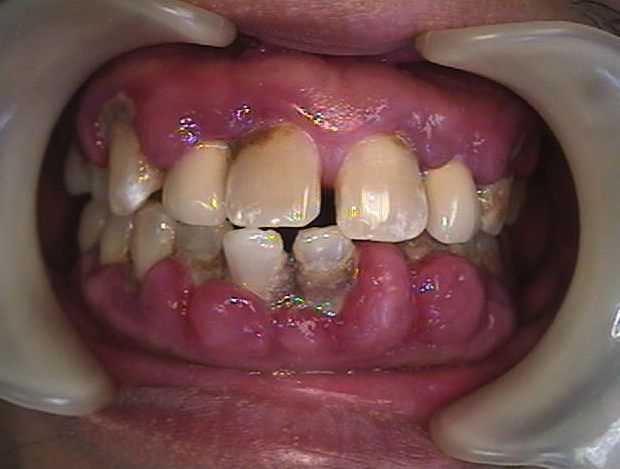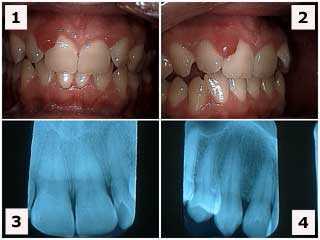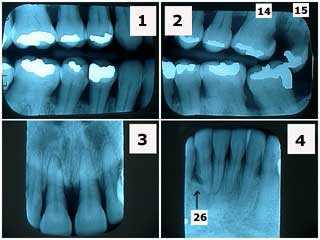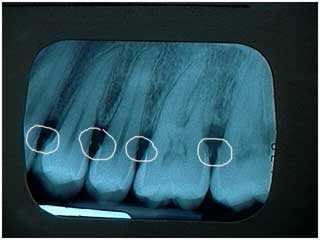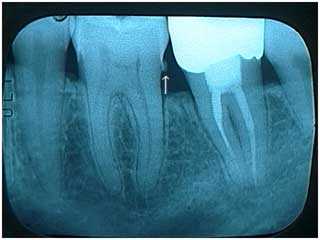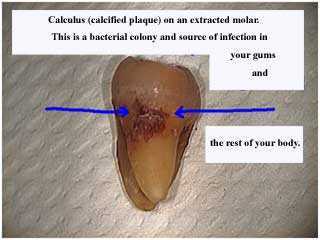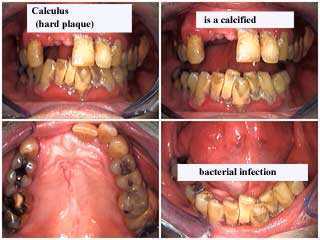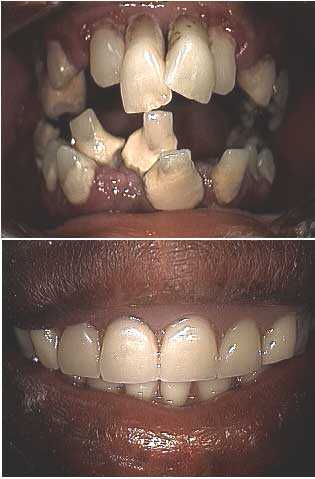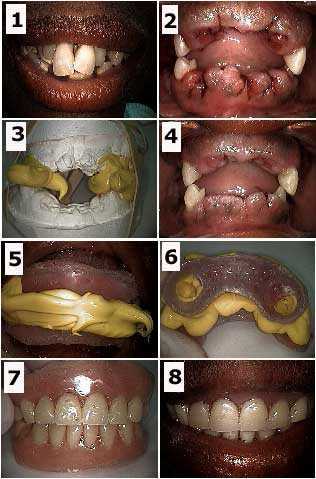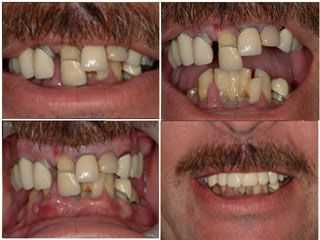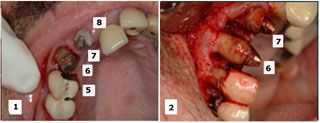Before and after photos on plaque and calculus are bacteria and germs in mouth performed in our Gum Disease Treatment office.
This photo documents the effects of using Calcium Channel blockers with inadequate periodontal maintenance – in the presence of dental plaque and calculus. Calcium Channel blockers are commonly used to treat high blood pressure, angina pectoris and coronary artery disease. Physicians should obtain periodontal clearance that the patient is reasonably free of periodontal disease causing bacteria before prescribing such medication.
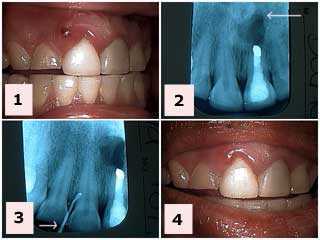
Acute periodontal oral abscess that resulted in tooth and gum pain. This patient did not have noticeable dental plaque or calculus that would explain this abscess. 1) This patient presented with this fistula between the gums of teeth #’s 7 & 8. Tooth #’s 8 & 9 had acrylic veneers placed elsewhere about two years ago. Her general dentist had performed a gingivectomy gum surgery last year to attempt to treat the occasional swollen gums in this same area. 2) The radiograph of tooth #9 shows a healed apicoectomy from 12 years ago that is not related to the current problem. 3) A gutta percha point was placed in the fistula gum boil and x-rayed to see where it lead. It stayed at the coronal gingiva near the veneer margin. The patient was put on tetracycline antibiotics for a week. [This is not a recommendation for everybody!] 4) Periodontist reevaluation two days later showed improvement in the infection and pain symptoms and resolution of the gingival inflammation. Recontouring of the veneer margin will occur following resolution of the acute condition. The focus is on mechanical irritation caused by the veneer since no discernible plaque and calculus was seen to account for the dental infection. Photo #1 of 2.
Close up of acute periodontal oral abscess that caused significant gum pain. This patient presented with this draining fistula – gum boil – between tooth #’s 7 & 8. Tooth #’s 8 & 9 had acrylic veneers placed elsewhere about two years ago. Her general dentist had performed a gingivectomy last year to attempt to treat the occasional gum swelling in this same area. A gutta percha point was placed in the fistula and radiographed to see where it leads. It stayed at the coronal gingiva around the margin of the veneer. The patient was put on tetracycline antibiotics for a week. [This is not a recommendation for everybody!]. Reevaluation two days later shows improvement in symptoms and gingival inflammation. Recontouring of the veneer margin will occur following resolution of the acute condition. The focus is on mechanical irritation caused by the veneer since no discernible plaque and calculus was seen to account for the dental infection. Photo #2 of 2.
Acute periodontal abscess that did not cause tooth pain. This patient had not been to the dentist for over two years. The x-rays look normal; i.e. there was not x-ray evidence of dental calculus. He received a dental prophylaxis cleaning and was placed on a chlorhexidene mouthwash. He was rescheduled for scaling and root planing with the dental hygienist and then further reevaluation with the Periodontist.
These x-rays show severe periodontal gum disease in a 40-year-old female dental phobia patient. Note the significant horizontal bone loss and the lack of radiographic calculus; this frequently indicates that the species of gum disease bacteria germs is more pathologic and should be of greater concern to the dentist and patient.
In other words if there is a lot of obvious teeth plaque and calculus then it would reasonably explain significant bone loss. But if there is very little teeth plaque and calculus but there is significant bone loss then the bacterial species of the few bacteria present must be highly virulent or particularly unhealthy. Not all species of mouth bacteria are the same.
Tooth #26, adjacent to the vertical bony defect, is probably hopeless. This patient was treated with two rounds of scaling by the dental hygienist and then periodontist reevaluation. Tooth #15 was extracted and #14 had root canal therapy and a dental crown.
Xray radiographic calculus. Calculus is plaque that becomes hardened by absorbing salivary calcium and then becomes evident on x-rays. It usually indicates the chronic presence of dental plaque and is not healthy. A dental prophylaxis cleaning is usually first performed by a dental hygienist – and then possibly scaling and root planing. This is then typically followed by Periodontist reevaluation.
X-ray Radiographic calculus. Calculus is plaque that becomes hardened by absorbing salivary calcium and then becomes evident on x-rays. It is usually indicative of the chronic presence of plaque and is not healthy. A dental prophylaxis cleaning is usually first performed by a dental hygienist – and then possibly scaling and root planing. This is then typically followed by Periodontist reevaluation.
A photo of dental calculus – calcified plaque – on an extracted molar tooth. This is a colony of bacteria – germs -and the source of infection in your gums and the rest of your body. If your gums are infected so are you!
Gross Calculus – calcified plaque – in an elderly man.
if there is a lot of obvious teeth plaque and calculus – as seen in these pictures – then it would reasonably explain significant bone loss. But if there is very little teeth plaque and calculus but there is significant bone loss then the bacterial species of the few bacteria present must be highly virulent or particularly unhealthy. Not all species of mouth bacteria are the same.
Full mouth oral rehabilitation of a phobic 36 year-old female. Notice all the calculus on these teeth. Initial result: two visits. Photo #1 of 4.
Full mouth oral rehabilitation of a phobic 36 year-old female. Notice all the plaque and calculus on the teeth in these pictures. Photo #2 of 4.
Full mouth oral rehabilitation of a phobic 36 year-old female. In these pictures note how many teeth extractions were necessary because of the gum disease caused by the plaque and calculus. The mouth bacteria germs destroy the jaw bone around the teeth. Photo #3 of 4.
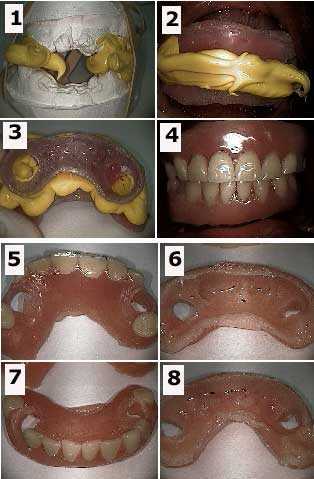
Full mouth oral rehabilitation of a phobic 36 year-old female. The treatment plan is to let the patient’s mouth heal after removal of all the plaque and calculus and the associated bacterial infection in her mouth and jaws. Dental implants will be the next step following wound healing. These pictures show how to fabricate an interim temporary prosthesis. We prefer to make fixed temporary dental crowns but in this case there was extensive teeth damage.
1) Working models and bite made right after the teeth extractions. This will serve for the fabrication of the immediate denture. 2) Intra oral view of bite rims and bite material. 3) Extra oral view of bite rims and bite material. The patient did not want any wire clasps to be used to retain the prosthesis. 4) Intra oral view of the immediate dentures. A soft reline material was used on the gingival side of these dentures. This soft reline material was allowed to flow into the circular openings in the acrylic denture as it was seated. This soft reline material provided retention instead of using clasps. 5) & 6) Pictures of the upper denture with soft reline material visible. 7) & 8) Photos of the lower denture with soft reline material visible. Photo #4 of 4.
Initial before and after Smile Makeover pictures. Notice the plaque and calculus particularly on the lower front teeth. Eventually the dental infection reaches a point where the mouth considers the tooth a foreign body and pushes it out of the jaw bone.
Selective tooth extraction during an upper oral reconstruction. The initial treatment plan considered saving teeth #’s 6, 7 and 9 while extracting #’s 5 and 8. During the periodontal gum surgery, #5 was considered more stable than #6 so #5 was retained and #6 was extracted because of significant tooth mobility.
This tooth mobility was caused by the presence of plaque and calculus deep on the root of this tooth. The tooth and gum infection caused bone loss around the tooth that resulted in tooth mobility.
